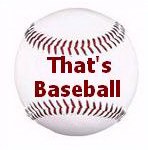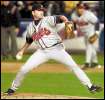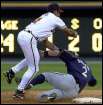 |
Baseball Terms
B
|
 |
Companion Sites: Nevada Dusters They Played the Game
|
||
A C D E F G H I J K L M N O P Q R S T U V W X Y Z
|
||
     |
||
Babe Ruth Baseball
Founded in 1951, this nonprofit organization supports summer leagues for youngsters age 9-18.
backdoor slide
An unconventional slide in which the baserunner's body goes past the bag before he touches the bag, normally resorted to when the runner realizes he is in danger of being tagged out.
backdoor slider
A slider that starts outside but slices in over the outside corner of the plate. Also used to describe a slider thrown by a RHP to a left-handed batter that crosses the plate moving away from the batter.
back end
The trailing runner in a double steal.
backhand
Fielding a ball by reaching the glove across the body.
back off
A pitcher is said to "back a batter off" when he throws inside in an effort to move the batter away from the plate.
backstop
(1) A screen behind and extending over the home plate area, designed to protect spectators from foul balls. The backstop must be a minimum of 60 feet away from home plate in the majors. First used: Boston Daily Globe, Mar. 27. 1872. (2) A catcher.
back up
In fielding, to move into a supporting position where one can retrieve a ball if another fielder can't reach it or muffs it. For instance, a pitcher sometimes backs up the third baseman who is about to receive a throw from the outfield, or the ssecond baseman may move over towards the first base line, behind the first baseman, when the latter is about to receive a throw from the catcher.
backup
A player who fills in for a regular. A substitute. First used: DeWitt's Base Ball Guide, 1869.
backup slider
A slider thrown over the middle of the plate when the catcher has set up to one side.
backward runner
A baserunner who, having advanced one or more bases, is forced to return to a previous base. If such a runner has tagged a new base while advancing, he must retouch that base before returning to the original one; e.g., a runner, leaving first base as a ball is hit to the outfield and thinking it will hit the ground, crosses second base and advances beyond third, then realizes that the ball is caught, must return to first, making sure to retag second base on the way. -- Dickson Baseball Dictionary.
bad-ball hitter
A hitter who chases pitches outside the strike zone. In most cases the end result is not a good one for the batter, although some players became "good" bad-ball hitters, i.e. Hank Aaron and Roberto Clemente.
bad bounce
When a batted ball bounces in a direction unanticipated by the fielder. Usually caused by an irregularity in the field. Also, bad hop.
bad call
A ruling by an umpire that is perceived to be incorrect, such as when a strike is called a ball, or when a baserunner reaches base safely but is called out.
bad hands
Said of a player who is a poor fielder.
bag
A square canvas sack filled with sand, sawdust or some other material, which is used to mark first, second and third base. First used: Spirit of the Times, 1857.
bagger
Term used to express the extent of a hit, as in "two bagger" for a double, or "three bagger" for a triple.
bail out
When a batter steps away from a pitch. This usually occurs when an inside pitch appears to be coming straight at the batter.
balk
An illegal act or motion by the pitcher that an umpire decides was intended to deceive a baserunner into making a move. When a balk is called the ball is dead and all runners advance one base. Usually the balk move is called when the pitcher steps on the rubber and appears to be about to deliver to the plate, but doesn't, or when the pitcher fails to come to a stop after the stretch. There are fourteen specific balk situations in the rules. First used: Knickerbocker Rules, 1845.
ball
A pitch judged to be outside the strike zone by the umpire, and which is not swung at by the batter. First used: Knickerbocker Rules, 1845.
ball boy
A young man assigned the task of retrieving foul balls. Also, ball girl.
ball club
(1) A baseball team. (2) An organization which supports a baseball team.
ball hawk
(1) A very fast, skilled outfielder, such as Ducky Medwick and Willie Mays. (2) A person who collects balls hit out of the park or into the stands as souvenirs.
ballpark
An enclosed baseball field that includes areas for spectators. A stadium. First used: Baseball Magazine, June, 1908.
The first such enclosed playing area was Union Grounds in Brooklyn, NY, which opened on May 15, 1862. The enclosure was invented and designed by William Cammeyer -- Dickson Baseball Dictionary.
ballplayer
(1) A professional baseball player. (2) Anyone who plays baseball. First used: 1862, correspondence of the Knickerbocker Base Ball Club.
balls and strikes
The count on a batter.
Baltimore chop
A batted ball that hits the ground close to home plate and bounces high in the air, giving the batter time to reach first base. First used: 1910, Baseball Magazine, April.
Despite the fact that the term did not begin to show up in print for several decades, it got its name, by all accounts, in the 1890s when the tactic was perfected by Wee Willie Keeler of the old Baltimore Orioles. Two other Baltimore batsmen (John McGraw and Wilbert Robertson) also used it as a method to get on base. Evidence suggests that at the Orioles' field, the dirt near home plate was purposely hardened to make the ball bounce higher -- Dickson Baseball Dictionary.
banana
(1) A good player. (2) A throw in which the baseball curves too much and misses its mark.
bandbox
A small ballpark where home runs are easy to hit.
e.g., Baker Bowl in Philadelphia in the early 1930s and Ebbets Field in Brooklyn in the 1950s. Today the term is most likely to attach itself to Fenway Park ... in Boston and Wrigley Field in Chicago. Among the newer ballparks, the term has been applied to Oriole Park at Camden Yards, The Ballpark in Arlington, and Coors Field. The term is sometimes used to suggest that a batter's numbers are less impressive because of the dimensions of his home field -- Dickson Baseball Dictionary.
First used: Sporting Life, Feb. 10, 1906.
bang-bang play
An attempted tag when the runner and the ball reach the base simultaneously.
banjo hitter
A batter who cannot hit the long ball. Some banjo hitters, like Bert Campaneris, were nonetheless very effective in getting on base.
baptism
Using rubbing mud to remove the sheen from a new baseball before it is put into play. Usually performed by the home plate umpire.
barber
(1) A talkative player. (2) A pitcher who throws close to a batter's head. (3) A pitcher with such pinpoint control that he can "shave" the edge of the strike zone.
barn ball
A forerunner of baseball that survived after baseball was created. It was a game of two players, a ball, a bat (usually an ax handle or stick), and the side of a barn or other building. One player threw the ball against the barn for the other to hit with the bat. If the batter missed and the pitcher caught it, the batter was out and the pitcher was up. However, if the batter hit the ball he had a chance to score a run if he could touch the barn and return to his batting position before the pitcher could retrieve the ball and hit the batter with it -- Dickson Baseball Dictionary.
Baseball Annie
A baseball groupie; an unattached woman who follows ballplayers around.
baseball arm
A sore arm caused by playing baseball. Also, baseball finger, caused by damage to the tendon at the fingertip caused by the repeated impact of a ball. Also, baseball pitcher's elbow, the fracture of bone or cartilage from the head of the radius at the elbow due to strenuous pitching; also, baseball shoulder, caused by the buildup of calcific deposits and fraying of tendons in a player's shoulder.
Baseball Assistance Team
An organization that raises money for indigent ballplayers.
Baseball Chapel
Based in Bloomingdale, NJ, this organization of major and minor league players seeks to spread the Christian gospel to other ballplayers throughout North America.
Baseball Player of the Year
Originally, an annual award presented by Seagram's Distillers and based on fan voting. Since 1988 it's been given by the Associated Press, and is based on the voting of sportswriters and broadcasters.
baseball rule
A legal construct that protects teams from lawsuits brought by spectators who have been injured by flying bats, baseballs, etc.
Baseball Writers Association of America
Founded in 1908 and consisting of writers and beat reporters, the association participates in Hall of Fame elections, is consulted on rule changes, and provides official scorers.
base coach.
The first base- and third base coach, who direct the batter and base runners and relay signs.
base hit
A single; a batted ball on which the batter advances to first base.
base jockey
A baserunner who shouts (often disparaging) comments at the opposing pitcher.
baseline
One of four lines connecting the bases, i.e., the "first base line" between home plate and first base. The first base- and third base lines are marked with chalk; the lines between first and second as well as second and third are usually not marked.
base on balls
A "walk"; an advance to first base awarded to a batter who has taken four pitches outside the strike zone. Before 1880 a walk consisted of nine balls; between 1880-82 it was eight balls, seven balls between 1882-84, six balls between 1884-86, seven in 1886, and five from 1887-89. First used: Chadwick Scrapbooks, 1858.
base open
A base not occupied by a baserunner.
basepath
The six-foot-wide lane connecting the four bases and in which the baserunner must run. He cannot leave the basepath to avoid a tag. First used: Baseball Magazine, Dec. 1910.
baserunner
A player on the team at bat who occupies a base. First used: DeWitt's Base Ball Guide, 1875.
bases loaded
When there are runners at first, second and third base. Syn: bases juiced, bases jammed, sacks full, full house.
base stealer
A runner who advances to the next base without benefit of a hit, an error, a balk, a passed ball, a wild pitch, a base on balls, or a hit batsman. First used: New York Press, Aug. 7, 1892.
base umpire
An umpire stationed at first, second, or third base.
Basic Agreement
The overarching labor contract between the owners (Player Relations Committee) and players (Major League Baseball Players Association) that contains virtually all conditions of employment, including pension benefits, minimum salary for major-league players, salary arbitration, rules that govern free agency, and working conditions such as scheduling, discipline, and travel. It was attained as a result of the 1981 baseball players' strike and is renegotiable every three years -- Dickson Baseball Dictionary.
basket catch
A catch in which the fielder cups glove and bare hand together, belt high, and against or near his body. Not usually recommended by coaches.
bat around
When all nine batters in the lineup come to the plate in the same inning.
bat boy
A young man employed by a team to tend to the personal equipment of the players during a game, who retrieves a player's bat from the vicinity of home plate after the batter's at-bat, and who supplies the home plate umpire with baseballs. First used: Baseball Magazine, July, 1909.
bat cleanup
To bat in the cleanup position -- fourth in the lineup.
bat control
The expertise in using a bat to execute a specific task, such as hitting into the gap, making contact in a hit-and-run situation, or fouling off pitches.
bat a thousand
To be perfect at the plate. An average of 1.000 is a practical impossibility after ten or so at-bats.
|
||
    |
||